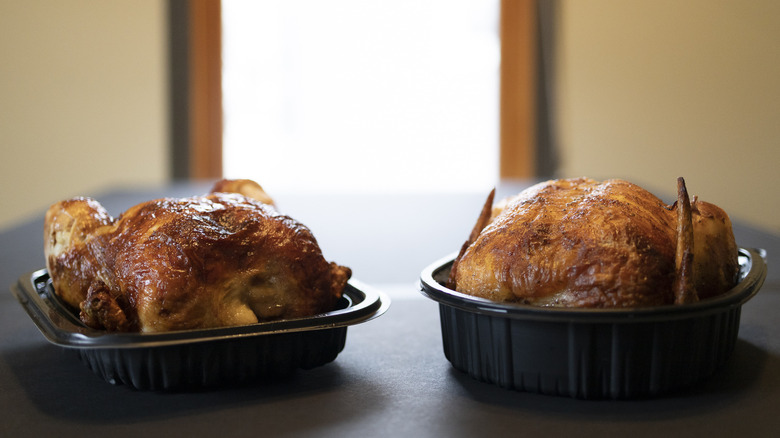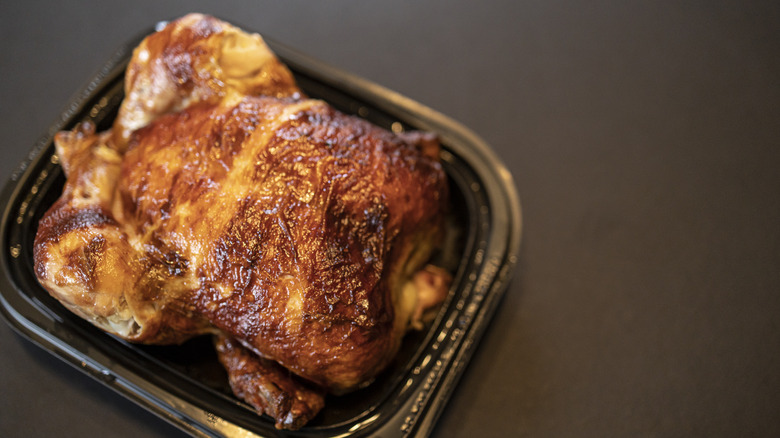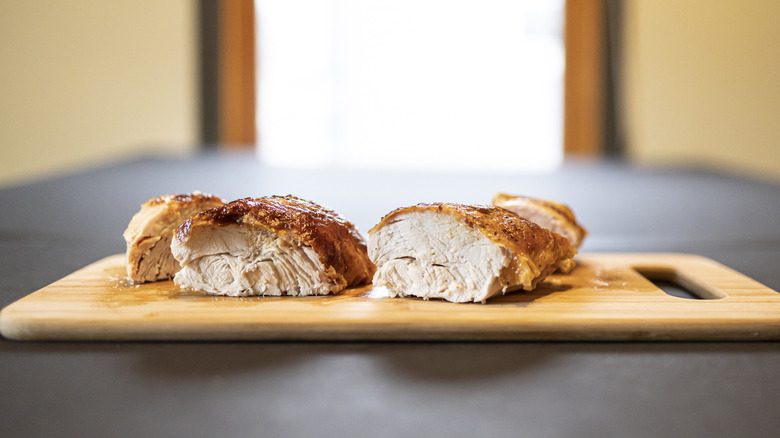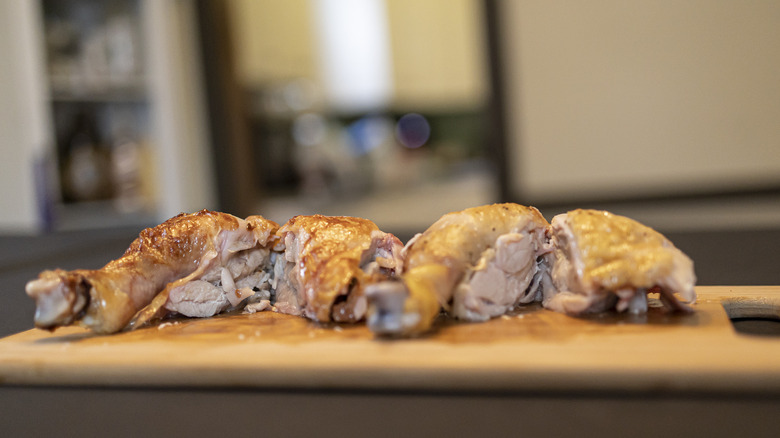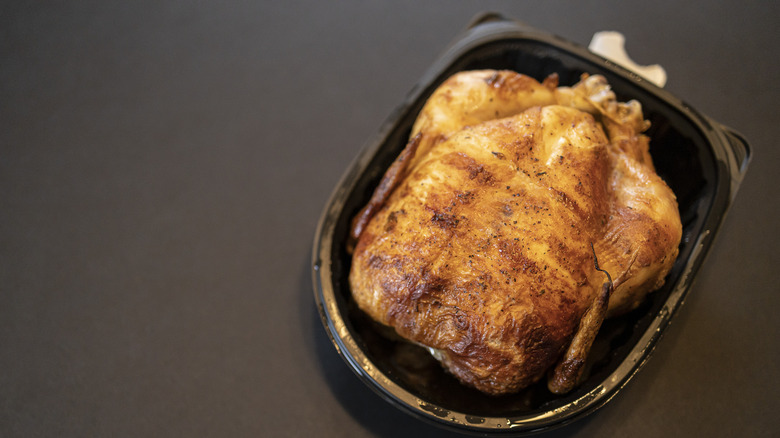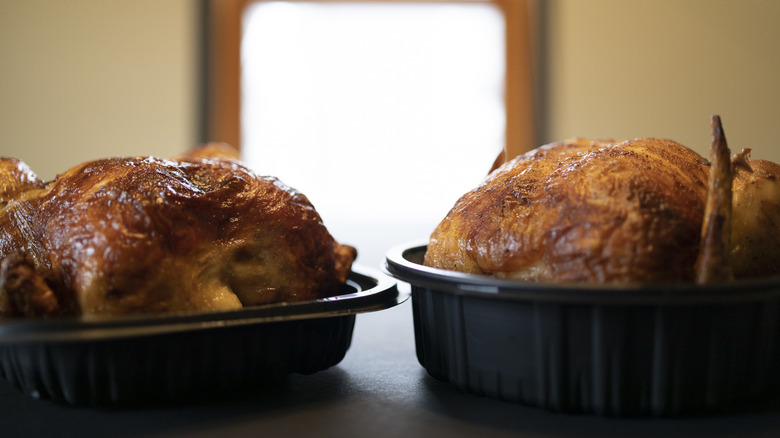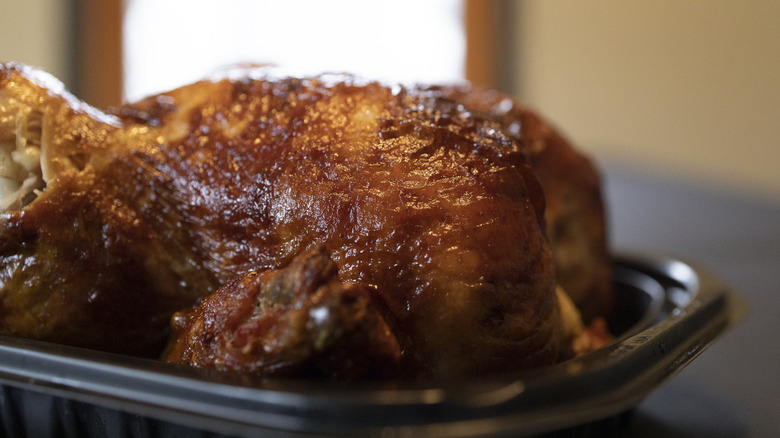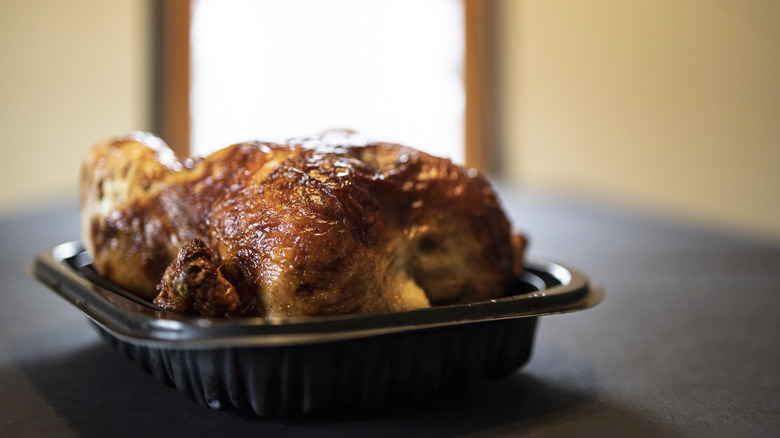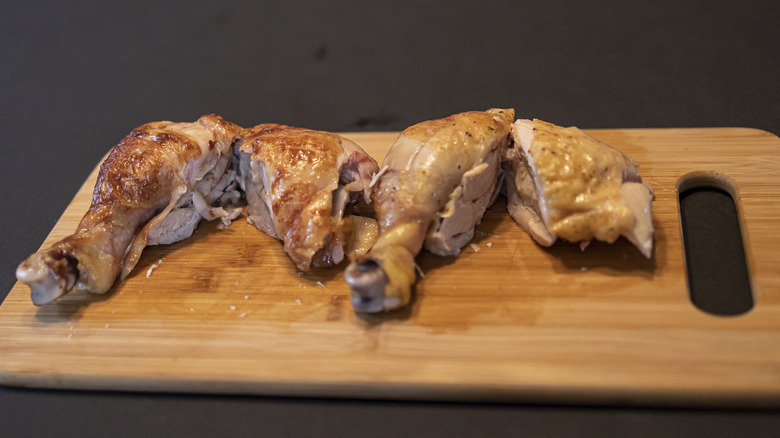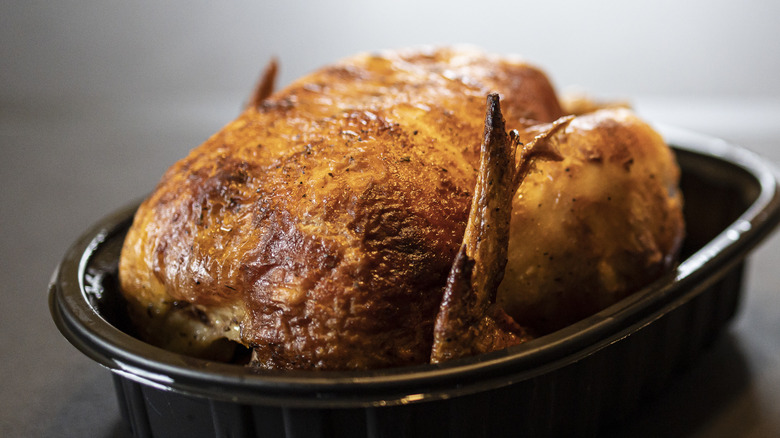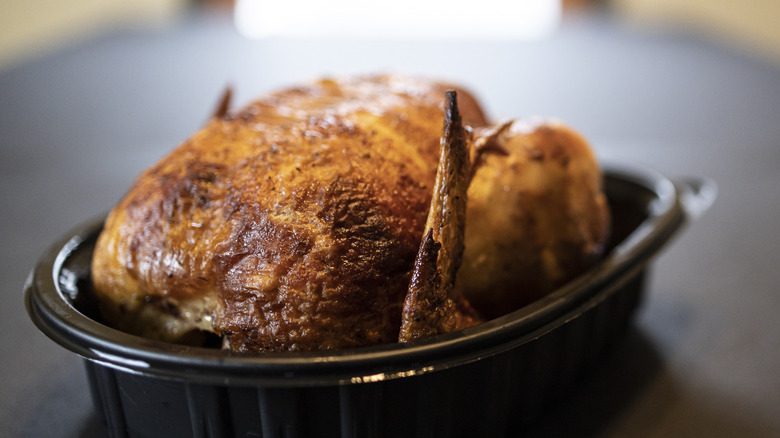Costco Vs. Sam's Club: Which Has The Better Rotisserie Chicken?
Rotisserie chickens are a lifesaver in busy kitchens. A rotisserie chicken is a beautifully-presented, fresh-made bird complete with a crisped-to-perfection skin and the best seasonings. It pairs exquisitely with mashed potatoes, roasted vegetables, or your favorite salad. You can serve it in quarters, shred it up for a soup, or slice it up for chicken sandwiches. But just what, exactly, is a rotisserie chicken, and what makes it any different from oven-roasted, grilled, or fried chicken? Rather than being battered and submerged in hot oil, or placed on a stationary grate, cooking a chicken on a rotisserie means that it is slowly turned on a spit next to a heat source. This could be in an oven or a designated rotisserie machine — like what is used for supermarket rotisserie chickens.
In fact, it seems downright illogical that something so convenient and accessible is so affordable at American grocery stores — it really decimates the appeal of spending the money on roasted chicken at a restaurant or the time spent on making one at home, doesn't it? Many big grocery brands sell rotisserie chickens, but among the leaders are Costco and Sam's Club, two wholesalers that come head to head in more than just ready-to-eat birds, but especially those. We visited both stores to settle the debate once and for all: Between Costco and Sam's Club, who makes the better rotisserie chicken?
Which chicken had the best skin?
The skin of a rotisserie chicken should be golden, sticky, and crispy — and while visual spices and seasonings are a bonus, Costco's rotisserie chicken took an easy win over the contender from Sam's Club. The Sam's Club chicken clearly had more seasonings on it, which we believe impacted our decisions flavor-wise — more on that later — but it was also paler and soggy in some areas, looking almost undercooked or like it had sat in grease for too long. Costco's chicken skin didn't seem to have any spices or seasonings on it at all, but it looked like a perfectly-cooked skin, and gave an audible crackle when we pushed at the most crispy-looking parts.
Costco did lose a point where its skin had split on the legs and thighs, as seen in the lower left of the chicken pictured above. This, we knew, could be foreshadowing an overcooked chicken. But before getting to the meat of this bird battle, we cut off a bit of skin from each chicken to perform a taste test. And all of the visual cues were correct: From a seasoning perspective, Sam's Club's chicken was better, but because it was also soggy and very unevenly cooked all around the bird (the dark meat in particular appeared several shades lighter than the breast), Costco's skin came out on top as a result of its golden crunchiness, and because it tasted like a well-cooked chicken skin regardless of its lack of seasonings. Costco's superior skin can likely be credited at least in part to modified food starch, an ingredient used to boost that airy, crispy texture in battered foods.
Who makes a better white meat?
We need to talk about how dang good these birds are — rotisserie chickens are either brined, marinaded, or dry-rubbed with seasonings bringing flavor that's both robust and universal enough that the chicken can be used in a variety of applications. However, it seems that, because of how these chickens are cooked and because they are hot-held until snatched up by a shopper, every rotisserie chicken you buy comes with the risk that lurking below that golden crispy skin is chewy, dried-out white meat. We were braced for sawdust white meat with the Sam's Club chicken, because it was among the last three lonely birds still unclaimed on the shelves by the late afternoon. The Costco bird, on the other hand, was so fresh that the employee simply handed it to us rather than put it on the shelves.
To our surprise, the white meat from the Sam's Club chicken was noticeably better, most significantly in its texture. It was definitely cooked to perfection, while Costco's was drier and more crumbly. It's quite distinctly visible in the cuts of breast meat pictured above: Sam's Club's chicken, on the right, appears to be more moist and holds more shape than Costco's, on the left, which was falling apart during cutting and struggled to stay intact. On the other hand, though, Costco's white meat was much easier to separate from the chicken's bones, probably because it was falling apart. The two were pretty comparable in flavor, with Costco's being a bit more salty.
Who makes a better dark meat?
Since a lot of people feel that the dark meat is the best part of a chicken — dark meat is higher in fat content, leading to a tastier and more tender bite — we took extra care in this chapter of the consideration. The dark meat — meaning drum and thigh — of both brands' chickens looked pretty identical upon cutting into them: pinkish-white and evidently moist. Costco was the clear winner in this category, though. Not only was its bird more generous in dark meat, but the meat also had a more robust and interesting flavor than Sam's Club's, which was quite bland. The Sam's dark meat was very fatty, so there was a lot to carve around, but we think that contributed to the pleasant texture and moisture.
After testing the dark meat, it became apparent that the Sam's Club rotisserie chicken was better prepared overall. Even though Costco's dark meat tasted better, it was drier, more overdone. Again, it's visible in the side-by-side comparison that Costco (left) dark meat has less moisture and structure than Sam's Club's (right). If we were shopping for the best dark meat, or for dark meat that's intended to be eaten on its own and not mixed into a salad or soup, we would go for Sam's because of it being more enjoyable texturally speaking.
Which chicken had a better flavor overall?
We found that in taking all of the major components into consideration — the juiciness and flavor of both white and dark meat, the overall cooking quality of the chicken, and the trademark crunchiness of a rotisserie chicken skin — the Sam's Club's product emerged in the lead. Its skin wasn't cooked as well and its dark meat flavor left something to be desired, but we couldn't overlook the fact that its chicken was more pleasant to eat overall compared to Costco's. There's also the significant fact that we really didn't taste much seasoning on Costco's chicken besides salt. Per Reader's Digest, Costco injects their birds with a saline solution — that brings the sodium in each serving up to around 460 milligrams, according to our chicken's nutrition label, which also doesn't elaborate on the seasonings beyond "spice extractives."
To be fair, we don't entirely know how the Member's Mark bird is seasoned, either, but our chicken's label did at least disclose the use of paprika, garlic, sugar, and onion among its flavorings. But regardless, Sam's Club's spices were more present and provided a lot more interest to the chicken when it's eaten on its own. Costco's generally blander meat might actually be better for sensitive palates and for using the chicken in cooking, but for actually using a rotisserie chicken as the main in a meal, Sam's Club had the better flavor overall, although it was a bit oilier than Costco's.
Which chicken is better for you?
While we do think the circumstances of where you are a member — and as a result where you're doing your shopping — will have the most sway in where you buy your rotisserie chicken, nutrition might be priority enough to have an impact, too. We have to say, nutrition seems to be a pretty even draw across both brands. It depends on which stats matter to you, although in our opinion Sam's Club's chicken pulls slightly ahead. According to the nutrition labels on our Sam's Club and Costco chickens, Sam's Club's unsurprisingly contained less sodium, coming in at 430 milligrams per serving as opposed to Costco's 460. We expected these numbers given the salty taste of Costco's chicken, but thought there would be a greater gap between the two; maybe the salt in the Sam's Club meat was disguised by the other spices.
Both brands level out in calorie counts per serving at 140, but the Member's Mark bird contains a bit more saturated fat (2.5 grams compared to Costco's 2 grams). Costco chicken is higher in cholesterol — 85 milligrams compared to 75 milligrams — and also has more carbs (2 grams, Sam's Club's says it has none) and less protein (18 grams versus 19 grams), but marginally more fiber, 1 gram over none.
Which chicken is the better value?
Costco and Sam's Club rotisserie chickens are already great deals, especially when compared to other chains like Whole Foods, which charges over $12 for a rotisserie chicken at the location nearest to us. In fact, both brands are pumping out these birds at a loss, according to reports like one published in the Reader's Digest. Cost-wise, Sam's Club was the better deal at our local wholesaler locations, but that's only if you're splitting hairs — the Sam's chicken was $4.98, only a penny better than Costco's price of $4.99. You could factor in the fact that Sam's Club membership as a whole is cheaper than Costco's — $50 for the basic membership at Sam's, $60 for the basic at Costco — but each brand brings a slew of other perks that would need to be compared, too.
Taste of the meat aside, we did get a bigger chicken with more usable meat at Costco than we did at Sam's Club. So in disregarding the different costs of shopping at these locations in the first place, and in considering the one-cent discrepancy to be too minimal to be impactful, that puts the Costco chicken in the winner's circle for value.
Which chicken reheated the best?
One of the best parts about rotisserie chickens is the leftovers you get to use throughout the week. If the chicken is shredded and deskinned, reheating typically isn't an issue — there's no worry about the skin crisping back up to at least a fraction of its original state. We reserved parts of each chicken with the skin on to test different methods of reheating. What we found was that the Sam's Club rotisserie chicken reheated well in the oven, but tasted super fresh when reheated in an air fryer, almost better even than the day we bought it. We assumed that this was because that chicken's skin needed some help crisping back up since it was a bit soggy in the first place, and because the Sam's chicken was moist enough not to be dried out by the convection. The piece of the Costco chicken that we reheated in the air fryer crisped back up, too, but was noticeably dry.
The most successful reheat of the Costco chicken was in the microwave, in terms of preserving the moisture and texture. Any other method appeared to significantly dry out and degrade the overall texture of the meat. And since microwaving is the harbinger of sogginess for any sort of crispy food, you know the chicken skin was a loss. Reheated Sam's Club chicken for the win.
Which chicken was easier to debone and shred?
One of the most popular ways to use rotisserie chicken is to bring it home, shred it, and dump it in a soup or salad. But cutting up an entire bird like that can be tricky, so when it comes to disassembling the chicken, we wanted to find out how much of a pain carving, deboning, and separating would be. This is where we discovered quite a bit more fattiness in the Sam's Club chicken — which probably contributed at least in part to how well this bird retained its moisture even in the white meat — as well as noticeably more tendons and gristle to saw through. This made navigating the Sam's chicken tougher, and the meat just in general didn't come off the bone as easily as the Costco chicken meat did.
We've always found removing the dark meat quarter to be the most difficult part of carving a chicken, particularly where that bone in the thigh rests in the socket on the main part of the bird. With the Costco chicken, even the dark meat quarter was no hassle at all to cut off. On the other hand, while trying to get one of the quarters off the Sam's chicken, that thigh bone was so stubborn that the entire dark meat quarter had fallen apart by the time we finally got it off.
Which chicken tasted better two days later?
You want to be careful about hanging on to rotisserie chicken too far past its expiration date — in fact, both of our chickens had a best-buy date of the very next day after it was made. But as long as your two-day leftovers are properly stored, the odds of the chicken going bad by that point are pretty low. After the first day of leftovers, we only use leftover rotisserie chicken for hot dishes where it will be thoroughly reheated to be on the safe side.
For this test, we reheated shredded chicken from both brands in the microwave for equal amounts of time. The Sam's Club chicken, by this point, had a faint but still unpleasant aftertaste of old, spent fryer grease — probably because of how oily the chicken was on the day it was made. And without the seasonings on the chicken skin to disguise it (since this meat was deskinned and shredded), that aftertaste was all we could think about. The Costco chicken fared better taste-wise on day two. It was sadly quite dry, but we expected that since even the fresh chicken was on the drier side. Overall, the Costco chicken just had a better, less stale flavor on the two-day reheat — and if you put it in a hot dish, you probably wouldn't even notice that dryness.
Overall, which chicken is the best?
The final and most difficult question: If we had to pick one, considering only these two samples and no past shopping, where would we buy a rotisserie chicken again? To reiterate, Costco had the better skin and tastier dark meat, and was a better value-to-price ratio. Sam's Club chicken had the better flavor overall, it was cooked closer to perfection than Costco's, and had a slim lead in nutritional statistics.
Proximity of Sam's and Costco will make a difference in terms of convenience. There are slightly more Sam's Clubs in the United States, but Costcos have the lead on total locations worldwide. Some might want to take the membership costs of each wholesaler into consideration, as well, especially if you live in a place where access to both locations is equally convenient. Sam's Club memberships are cheaper at $50 for the baseline membership, which only puts the Member's Mark chicken further ahead of the Costco chicken, since the other wholesaler's baseline membership is $60.
Tallying all of these points up, we have to award the distinction of the best overall rotisserie chicken to Sam's Club. If we wanted a bunch of meat to shred for sandwiches, salads, or soups, Costco would be the better choice, but we focused the judgment of this article on purchasing a rotisserie chicken with the intent to serve it as the focal piece of a main course, accompanied by sides. The Member's Mark bird delivered on juicier meat, a (barely) more affordable dinner, and a flavor that was cluckin' good.
